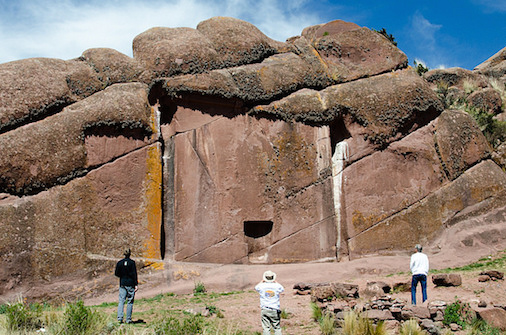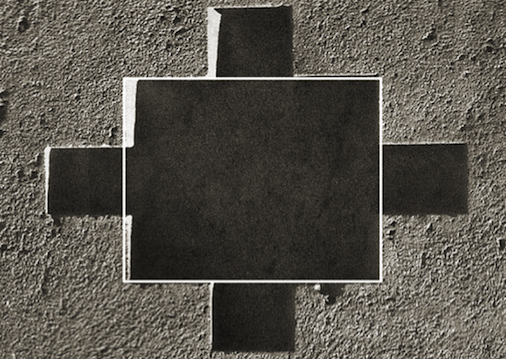In this guest blog best-selling author and tour leader for our upcoming Peru journey, “Welcome to the Portals of Peru”, Freddy Silva continues his exploration of Peru’s sacred sites, focusing on the portal of Amaru Muru, near Lake Titicaca. Read Freddy’s first instalment: The Otherworld in the Andes.
Southeast of the sacred sites [of Silustani and Cutimbo] lies a third, a sandstone massif on the western edge of Lake Titicaca, and it too is linked with the Otherworld. The hill is called Hayu Marca, literally “Gate of the Spirits”. Long ago, when the water level of this inland sea surrounded it, the hill was an island resembling a large teardrop, much like Glastonbury Tor once did. And along its façade, nameless people carved a monumental portal and called it Amaru Muru

Amaru means “serpent” in Qechua, and as with similar locations around the world, the designation identifies the site as a conduit for the Earth’s telluric currents. Together with the high content of iron oxide already present in the rock, the place leaves an indelible impression on anyone who ventures here. The Catholic zealots who conquered this land felt unnerved by it, so much they called it the Devil’s Doorway. Local people often report a blue light emanating from a tunnel inside the rock, or strange people dressed in unusual clothing emerging from it and travelling towards Lake Titicaca.
The oldest legend describes Amaru Muru as “a doorway to the lands of the gods,” and how in times long past great heroes passed through this gate for a glorious new life of immortality in the Otherworld. A hollow niche at the base faces the rising Sun at the Equinox and accommodates a person of average height. Curiously, the work bears a passing resemblance to Egyptian “false doors” found in ritual chambers – symbolic portals through which the soul travels between worlds.

This portal into the Otherworld has a twin on the opposite side of the world, at Yazilikaya in Anatolia, and comparing the two would lead anyone to believe they were carved by the same artist. The vertical limestone outcrop has been incorrectly linked as the burial place of Midas, the fabled king who turned everything he touched into gold. However, the king’s body was never found here, not surprising given that Mida is the Phrygian surname of Cybele, a local adaptation of Demeter, the presiding goddess of the Greek Mysteries and its ritual of living resurrection. Above it, on the summit, there is a rock-cut altar and accompanying tunnels that lead 900 feet down into the bedrock, where initiation was conducted. The same is true of Amaru Muru. There exist vestiges of some kind of rectangular structure on its summit, while behind the portal a tunnel descends twenty-four feet into the rock face before reaching a brick wall, erected by the authorities lest anyone should disappear into the bowels of the Earth, because as pre-Inka legends claim, the tunnel extends 800 miles to Cusco.
Even stranger is the suffix kaya in Yasilikaya, because it is a Quechua word meaning “tomorrow”, while yaşlı in Central Asia is “a person of great age”. The genetic link between people of Central Asia and South America has long been known, but to add to this a linguistic bridge plus mirrored sacred sites sharing a common purpose implies a shared tradition of unfathomable age.
The Aymara of the Andes considered the Southern Cross constellation to lie in a sector of the Milky Way marking the entrance into the Otherworld. Their prime symbol was a cross called chakana, which means “to bridge or cross”, and reveals much about their recognition of the umbilical link between the here and hereafter and its importance in the conduct of human affairs. The oldest iteration of the design – a rectangle sprouting an uneven armed cross – is found in the temple of Tiwanaku and represents the three levels of existence: the Otherworld of gods, the Middleworld of Mother Earth, and the creative Underworld. Its design is defined by the unusual ratio 6:5, which is shorthand for the relationship between the Earth’s precessional cycle of 25,920 years divided by its 21,600-year axial tilt. This 6:5 ratio allows self-aware life to be established on Earth. No other rock in the solar system bears this ratio.

How the Andeans discovered this is a mystery, unless you accept they performed this out-of-body journey and pulled the information from an astral library; after all, initiates like Pythagoras and Plato stated how their philosophies were shaped by the knowledge gained from their own resurrection experiences.
To learn more about the rituals of living resurrection and the Otherworld join Freddy Silva this fall as he journeys to the sacred sites of Peru.
“Welcome to the Portals of Peru with Freddy Silva: Discover the Power Places of an Ancient Civilization” features visits to Amaru Muru, Silustani, Cutimbo, Machu Picchu, the Uros Islands, and more. Spaces are limited – visit our website today to read our full itinerary and book your spot on this trip of a lifetime.
©Freddy Silva 2015. Based on material from his book The Lost Art of Resurrection: Initiation, Secret Chambers and the Quest for the Otherworld. Available at www.invisibletemple.com